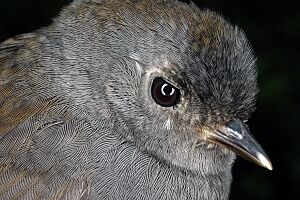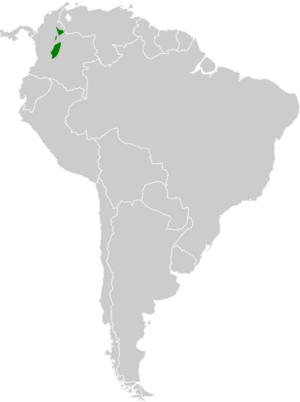Pale-bellied tapaculo facts for kids
Quick facts for kids Pale-bellied tapaculo |
|
|---|---|
 |
|
| Conservation status | |
| Scientific classification | |
| Genus: |
Scytalopus
|
| Species: |
griseicollis
|
 |
|
The pale-bellied tapaculo (Scytalopus griseicollis) is a small bird that lives in the mountains of Colombia and Venezuela. It's also sometimes called the matorral tapaculo or rufous-rumped tapaculo. This bird belongs to a family called Rhinocryptidae, which are known for being quite secretive.
Contents
About the Pale-bellied Tapaculo
Different Types of Pale-bellied Tapaculos
The pale-bellied tapaculo has three main types, called subspecies. Think of them like different versions of the same bird. They are:
- Scytalopus griseicollis griseicollis (the most common type)
- S. griseicollis gilesi
- S. griseicollis morenoi
The S. griseicollis morenoi subspecies was only officially described in 2015. Scientists used to think the pale-bellied tapaculo was a type of Magellanic tapaculo, but now they know it's its own unique species.
What Does This Bird Look Like?
The pale-bellied tapaculo is a small bird, about 10 to 11.5 centimeters (4 to 4.5 inches) long. It weighs around 16 to 19 grams (about 0.6 ounces), which is lighter than a few quarters!
Most adult pale-bellied tapaculos are gray, with a lighter gray belly. Their back and wings are a brownish-gray color. You might notice their rump, sides, and under-tail area are a pretty orange-brown.
The different subspecies have slight differences in their colors:
- S. g. gilesi has a darker back with less brown and darker gray underparts.
- S. g. morenoi has a brown area on its back, near its neck.
Where Do They Live?
The pale-bellied tapaculo lives in the Eastern Andes mountains of Colombia. One subspecies, S. g. griseicollis, is found in the Cundinamarca and Boyacá areas. Another, S. g. gilesi, lives northeast of that, in Santander. The S. g. morenoi subspecies is found even further north in Santander and Norte de Santander, and a little bit into Venezuela.
These birds like to live in low, bushy areas within elfin forest and páramo habitats. These are high-altitude places, from about 2,000 to 3,900 meters (6,500 to 12,800 feet) above sea level. Sometimes, but not often, they can be found in mountain forests or oak forests. They can also live in areas with Chusquea bamboo. These birds are quite tough and can even live in places where their habitat has been changed or broken up by humans.
How Pale-bellied Tapaculos Behave
What Do They Eat?
Scientists believe the pale-bellied tapaculo mostly eats insects. However, there isn't a lot of detailed information about what exactly they eat or how they find their food.
Reproduction and Life Cycle
Not much is known about how pale-bellied tapaculos raise their young. Young birds that had just left the nest (called fledglings) of the S. g. morenoi subspecies were seen in April, June, and September. Fledglings of the S. g. gilesi subspecies were found between June and December.
How Do They Communicate?
The songs of the different pale-bellied tapaculo subspecies sound a bit different, but they all make a trilling sound. Sometimes, they make a single note before the trill. You can listen to their calls online here. Their alarm call, which they use to warn others, is also a trill here.
Conservation Status
The IUCN (International Union for Conservation of Nature) has listed the pale-bellied tapaculo as a species of "Least Concern." This means that, overall, there are enough of these birds in the wild that they are not currently at high risk of disappearing.
However, some of the subspecies face challenges. The S. g. gilesi subspecies lives in a very small area. Also, the habitat for S. g. morenoi is very broken up and damaged, which could make it harder for them to thrive in the future.


